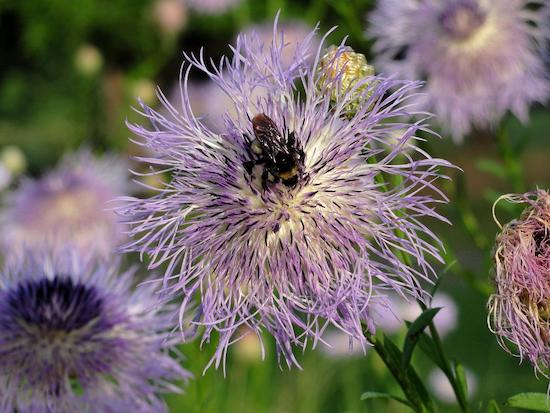
An East Texas native basketflower is pollinated by a bumblebee.
November 22, 2023 - Texas is home to up to 1,000 species of native bees. Unfortunately, most gardeners are only familiar with the non-native European honeybee. Bees are vital for the environment, and they need our help. Native bees, our unsung heroes, are struggling to find the food they need. We can make a difference right in our East Texas gardens by creating spaces where native bees can thrive.
Native bees, like bumblebees, carpenter bees, and mason bees are essential pollinators. They visit flowers to collect nectar and pollen, and in the process, they help plants make seeds and fruits. Here are a few keys to helping out native bees.
Choose Native Plants: Native bees are crazy about native plants. These are the ones that have grown here for a long time. Some favorites in East Texas include bluebonnets, coneflowers, and bee balm. Every native plant that isn’t wind pollinated evolved with specific pollinators to ensure their continued existence.
Year-Round Blooms: Bees need food all year. Fall is particularly important. Plant a variety of flowers that bloom at different times, from spring to fall. This way, they always have something to eat.
No Pesticides: Bees are very sensitive to insecticides. Avoid using them in your garden when you can and use baits and targeted and timely applications when you have to.
Bee Nests: Bees need a place to rest and raise their young. You can provide that by leaving some bare soil, dead wood, standing dead flower stems, or leaf litter in your garden. Many bees nest or overwinter in the ground, in holes in wood, or in leaf litter.
Watering Holes: Bees get thirsty too. Set up a shallow dish with water in your garden. Put some stones in it so they can land safely without drowning.
If you're wondering what to plant, here are a few ideas:
Bluebonnets: Our state flower, the bluebonnet, is adored by bees. It's a great choice for an East Texas spring garden.
Coneflowers: These native flowers are a bee favorite. They're tough, and they come in different colors.
Passionvines: Although these vigorous vines are host plant for Gulf Fritillary butterflies, they are pollinated by bees.
Salvias: These come in many species and colors, and they're known to attract bees as pollinators.
Sunflowers: These natives can be annual or perennial with all being attractive to native bees.
Consider setting aside a part of your garden for wildflowers. Native wildflowers are like a buffet for bees, and they make your garden look more natural and beautiful. Consider creating a pocket prairie full of native annuals, perennials, and grasses.
Spending time in your garden watching and learning about bees is not just fun; it's also educational. You can find books and online resources to help you identify different types of native Texas bees and learn about their habitats.
Supporting native bees in East Texas is about more than just creating a beautiful garden. It's about preserving our local environment and ensuring a bountiful harvest of fruits and vegetables. By planting native flowers, providing food all year, avoiding pesticides, offering nesting spots, and providing water, you can create a paradise for these important pollinators.
Remember, you're not just helping the bees; you're helping yourself. Bees make our food, flowers, and forests grow, so the more we do for them, the better off we all are. Together, we can make East Texas a haven for native bees and enjoy the beauty they bring to our surrounding natural landscape.
Greg Grant is the Smith County horticulturist for the Texas A&M AgriLife Extension Service. He is the author of Texas Fruit and Vegetable Gardening, Texas Home Landscaping, Heirloom Gardening in the South, and The Rose Rustlers. You can read his “Greg’s Ramblings” blog at arborgate.com and read his “In Greg’s Garden” in each issue of Texas Gardener magazine (texasgardener.com). More science-based lawn and gardening information from the Texas A&M AgriLife Extension Service can be found at aggieturf.tamu.edu and aggie-horticulture.tamu.edu.








